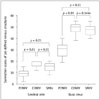Abstract
Objective
Materials and Methods
Results
Figures and Tables
 | Fig. 1Representative case for choosing optimal phase for SMRV from TRMRA of 64-year-old female.On time-intensity curve (D) of right common carotid artery (CCA; black curve, white circle in B) and internal jugular vein (IJV; gray curve, black circle in B), signal characteristics of phases A and B were identified. Phase A (A) corresponds to time point of start of venous opacification (thin line), not arterial peak phase (dashed line). Phase B (thick line) had maximum venous structure signal. Phase B (B) shows substantial arterial signal, which is not desirable in MRV images. Acquired SMRV (C) image shows that arterial signal was clearly removed and cavernous and inferior petrosal sinuses were clearly visualized. SMRV = subtraction MR venography, TRMRA = time-resolved contrast-enhanced MR angiography
|
 | Fig. 2Box plot of reviewer 1's cerebral vein and dural sinus scores of three MRVs.Presented P values were obtained from post hoc test (Wilcoxon signed rank test with Bonferroni correction). CEMRV = single-phase contrast-enhanced MR venography, MRV = MR venography, PCMRV = phase-contrast MR venography, SMRV = subtraction MR venography
|
 | Fig. 347-year-old female underwent MRV as part of her preoperative workup for midline meningioma.PCMRV (A), CEMRV (B), and SMRV (C) reveal abrupt obliteration of superior sagittal sinus (arrowheads) and prominent collateral cortical vein (empty arrows). Note unsuppressed signal of internal carotid arteries in PCMRV and CEMRV (asterisks), whereas internal carotid arteries are not seen on SMRV. Internal cerebral veins (arrows) are not visualized on PCMRV. Degree of visualization of straight sinus (double arrows) and vein of Galen are different in three MRV images. CEMRV = single-phase contrast-enhanced MR venography, MRV = MR venography, PCMRV = phase-contrast MR venography, SMRV = subtraction MR venography
|
 | Fig. 433-year-old man underwent follow-up MRV after diagnosis and treatment of right transverse sinus thrombosis.Right transverse sinus, sigmoid sinus, jugular bulb and even proximal internal jugular vein are not visualized (dotted circle) on PCMRV (A), and persistent thrombosis or stenosis could be suspected. Note arterial contamination (solid and empty arrowheads) on PCMRV. For this patient, timing of CEMRV (B) was suboptimal, and profound contamination of arterial structures (solid and empty arrowheads) and relatively weaker venous structure signal were observed. However, SMRV (C) enables clear visualization without contamination of arterial structures. Note clear visualization of right transverse and sigmoid sinuses (arrows). In addition, SMRV reveals very prominent paraspinal venous plexus. CEMRV = single-phase contrast-enhanced MR venography, MRV = MR venography, PCMRV = phase-contrast MR venography, SMRV = subtraction MR venography
|
 | Fig. 559-year-old female underwent MRV for preoperative workup of left parasagittal meningioma.On PCMRV (A), there is transverse vascular signal (empty arrow) where meningioma is located. Same vascular structure (empty arrow) is seen on CEMRV (B). Vascular structure visualized on two conventional MRV was thought to be draining vein from meningioma. On SMRV (C), this vascular structure is not seen. Instead, enhancing meningioma (asterisk) and tortuous cortical vein (double arrows) in superior aspect of meningioma are noted. TRMRA of arterial phase (D) reveals feeding artery (empty arrow) from middle meningeal artery (solid arrow), which is suspected as draining vein on conventional MRV. Note arterial contamination (solid and empty arrowheads) on PCMRV. CEMRV = single-phase contrast-enhanced MR venography, MRV = MR venography, PCMRV = phase-contrast MR venography, SMRV = subtraction MR venography, TRMRA = time-resolved contrast-enhanced MR angiography
|
Table 1
Image Quality and Arterial Contamination on Venography

P values were acquired using Friedman test. *Post-hoc analysis suggested that SMRV was better than other MRV techniques (p < 0.001), †Post-hoc analysis suggested that CEMRV was better than other MRV techniques (p < 0.001). Score of SMRV was not significantly different from that of PCMRV (p = 0.951 for reviewer 1, and p = 0.999 for reviewer 2). CEMRV = single-phase contrast-enhanced MR venography, MRV = MR venography, PCMRV = phase-contrast MR venography, SMRV = subtraction MR venography
Table 2
Summation of Scores of Individual Venous Segments

Scores were presented with median and interquartile range. P values were acquired using Friedman test. Presented scores were sum of scores of 14 dural sinuses, 5 cerebral veins, and 19 all venous segments. Scoring system for each venous segment is follows: 4 for intense and continuous, 3 for faint and continuous, 2 for non-continuous with small gap, 1 for non-continuous with large gap, and 0 for non-visible. *Dural sinus score of CEMRV and SMRV were not significantly different in post hoc analysis (p = 0.146 in reviewer 1, and p = 0.123 in reviewer 2). CEMRV = single-phase contrast-enhanced MR venography, PCMRV = phase-contrast MR venography, SMRV = subtraction MR venography
Table 3
SNR and CNR of MR Venographies

| PCMRV | CEMRV | SMRV | P | |
|---|---|---|---|---|
| SNR | 59.4, 49.2-74.9* | 150.3, 111.0-182.6† | 104.5, 83.1-121.2‡ | < 0.001 |
| CNR | 53.6, 43.8-69.2* | 148.4, 108.0-178.2† | 104.1, 74.9-120.5‡ | < 0.001 |
SNR and CNR were median and interquartile range. P values were acquired using Friedman test. Post-hoc analysis shows significant differences of SNR and CNR between different MRVs. *†‡Numbers with same superscripts in each row represent those are not significantly different in post hoc analysis. CEMRV = single-phase contrast-enhanced MR venography, CNR = contrast-to-noise ratio, MRV = MR venography, PCMRV = phase-contrast MR venography, SMRV = subtraction MR venography, SNR = signal-to-noise ratio




 PDF
PDF ePub
ePub Citation
Citation Print
Print


 XML Download
XML Download